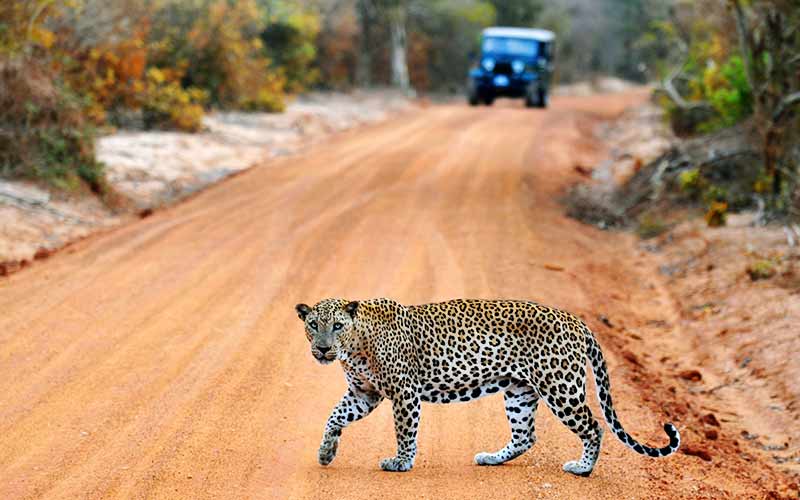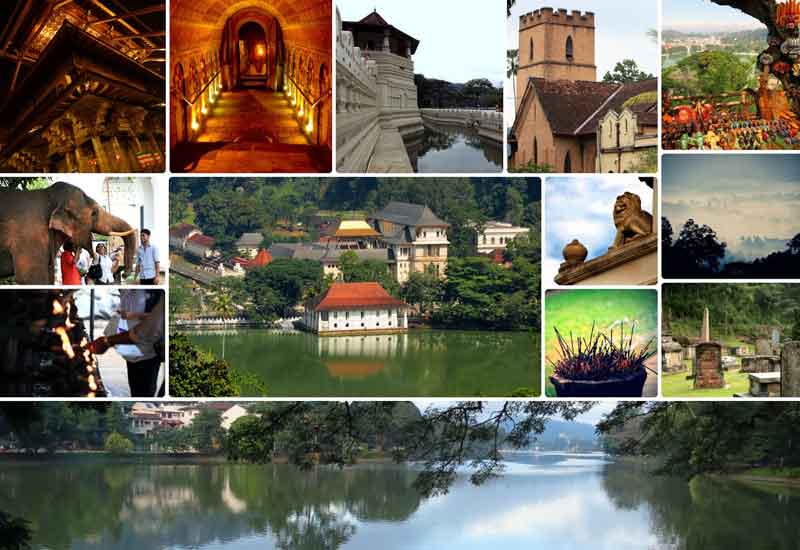Sri Lanka lies south of the Indian subcontinent and measures 450 kilometers from north to south and 230 kilometers from east to west. Around 5,000 years before Christ, the island separated from the mainland . A group of islands between Sri Lanka and India still testify. The country is subdivided into a total of three geographical zones: the central upland with up to 2,500 meters high mountains, which is known for its tea cultivation , the lowland and the coasts, which are excellent for fishing.
Overview of the island of Sri Lanka
Geography of Sri Lanka
Sri Lanka lies south of the Indian subcontinent and measures 450 kilometers from north to south and 230 kilometers from east to west. Around 5,000 years before Christ, the island separated from the mainland . A group of islands between Sri Lanka and India still testify. The country is subdivided into a total of three geographical zones: the central upland with up to 2,500 meters high mountains, which is known for its tea cultivation , the lowland and the coasts, which are excellent for fishing.
History of Sri Lanka
Today, the largest Sinhalese nation is due to the so-called Indo-Asian immigration. The tribe came from North India. As early as about 200 BC, Buddhism was established as a predominant religion. Anaradhapura became the capital. In the Middle Ages, Polonnaruwa and Sigiriya were temporarily government offices, which is why these cities have a rich cultural heritage.
In the last centuries, the country lost its independence by multiple colonization by various seafaring powers of Europe. At first the Portuguese landed in today’s Sri Lanka , later the Dutch and finally the English. In 1947, Ceylon became a British Dominion, the year after, the country became independent. Chandrika Bandaranaika Kumaratunga became first president. Currently, Mahinda Rajapaksa from the Sri Lanka Freedom Party ruled the country with just over 50 percent of the votes.
Population / religion
The largest population group in Sri Lanka is the Sinhalese. In addition, there are the Tamils, which are divided into two immigration waves. The former Tamils came to the island about 2,000 years ago – they are known as indigenous Tamils. Indian Tamils came to the island with a second wave during the colonial period and were used in tea cultivation areas. The decades-long conflict consists exclusively with the first group. The native Tamils populate the northeastern part of the country. In addition to predominantly Buddhist Sinhalese and Hindu Tamils, Sri Lanka still has a minority of Christians and Muslims.
Current situation: Hope for a new era

In May 2009, the 30-year-long civil war in Sri Lanka between Sinhalese and Tamil rebels was ended. Now there is reason to hope for a new era for the country. The latest visitor numbers from Germany speak for this. In recent months, the arrivals from Germany in Sri Lanka have risen by up to 75% compared to 2008. The Foreign Office has also significantly improved its travel notes and / or canceled the partial travel warning. According to the Federal Foreign Office, travel to the preferred tourist areas is possible: the coast in the south-west and south, the cultural triangle, the southern Landesinnere and the Yala National Park and around Arugam Bay (Last update: 30.11.2009).
The tourism authority of the island is currently developing a plan for the tourist development of the now accessible eastern provinces around Pasikudah, Arugambay, Trincomalee, Nilaveli, Waakarai, Verugal and Kalkudah. They are known for their fantastic beaches and excellent surf spots.
Economy in Sri Lanka
Germany is one of the most important trading partners, as well as India and the countries of Southeast Asia. The most important export items of Sri Lanka are tea, rubber and textiles. Furthermore, the country is the world’s largest exporter of cinnamon. The currency of Sri Lanka is the rupee. The price level is significantly lower than in Germany. Approximately 170 Rupees correspond to one euro. The currency of Sri Lanka should not be exported to Germany except for a few rupees.
Climate on Sri Lanka
Sri Lanka has a subtropical climate that is strongly influenced by the monsoon. It brings a lot of moisture on the west and south-west coast, especially in the spring around the month of May and around the month of November in the autumn. In summer, there is a drier intermediate phase. The best time of the year is when the winter is here, as the temperatures are slightly lower and the precipitation is much weaker. Visitors will find lower temperatures in the highlands. Around Nuwara Eliya around the highlands it may even snow. One of the greatest advantages with the development of the East is the climatic aspect. The southwest monsoon brings precipitation to the already developed west coast in the spring and summer months, while the winter is characterized by an ideal holiday weather in Sri Lanka . On the east coast the situation is exactly reversed with a dry phase in summer and a moister in winter. Both shores would complement each other climatically and offer visitors two high-season times per year.
Flora and fauna in Sri Lanka
Sri Lanka has a very rich flora and fauna. Large parts of the island state are covered by palm trees. Among the most important plants are rice, sugar cane, tea, tobacco, coffee and coconut. The Yala National Park in the South of Sri Lanka is a main attraction for nature lovers. The animals include monkeys, elephants, snakes and crocodiles. Bird lovers find a great variety of parrots and other birds as Sri Lanka is on the route of migratory birds from north to south. In addition, Sri Lanka has the largest leopard population in the world. Friends of elephants find in Pinnawela a rearing station for the popular pachyderms. In addition, there is a farm on the coast in Kosgoda, dedicated to the population increase of turtles.
In the ocean, divers and snorkelers get their money’s worth as there is a large coral and impressive fish stock on Sri Lanka.
Attractions in Sri Lanka
The most important seaside resorts on the western and southwestern coast of Sri Lanka include Negombo near the airport as well as Beruwela, Hikkaduwa, Wadduwa and Bentota south of Colombo. Also the capital itself offers in the southern part with Mount Lavinia beautiful sandy beaches and with the traditional, the same name a representative of the colonial architecture.

In the hinterland visitors will find the so-called cultural triangle between Anaradhapura, Kandy and Sigiriya, which offers indifferent sights on Sri Lanka .
Kandy is an old royal city and is visited mainly because of the dental temple. As the name implies, he is said to contain a baking number of the Buddha. Sigiriya is home to the famous Lion Rock. The ascent to the monolith rewards with impressive views over the surrounding area. The name comes from the giant lion head guarding the gate. Visitors will also find world-famous frescoes. The rock belongs to the Unesco world cultural heritage. Nuwara Eliya is considered as a former health resort of British colonial officials in high altitude with pleasant climate and Central European nature. Dambulla is best known for its cave temples. Old capital cities are Anaradhapura and Polonnaruwa. There are ruins of an old high culture in both places.
Colombo is the largest city on Sri Lanka. Its main attractions are the old colonial fort and the villas district of Cinnamon Gardens.
Kitchen in Sri Lanka
The cuisine of Sri Lanka is very diverse and characterized by different influences. For example, the Portuguese left their culinary traces. In general, the kitchen is characterized by exotic curry dishes, rice and lots of fish and seafood. Most of the country’s inhabitants eat fish, but they refuse meat – especially pork and beef. Tourists will find fish, meat, vegetables and exotic fruits in the hotel restaurants.
Ayurveda in Sri Lanka

The ancient healing art of Ayurveda is world famous and has a long tradition in Sri Lanka. All larger hotels offer appropriate treatments in spa centers. Some of the houses are dedicated exclusively to Asian medicine. Some guests opt for multi-week, holistic cures.
Travel / Travel in the country
The national carrier SriLankan Airlines connects Frankfurt four times a week on Wednesdays, Fridays, Saturdays and Sundays nonstop with the capital Colombo. If you are coming from Munich, Hamburg or Berlin, you will find convenient connections with Qatar Airways via Doha or Emirates via Dubai and Condor. The international airport of Colombo is located about 30 kilometers north of the capital.
In the country itself tour organizers offer excursions from the big tourist places to the Landesinnere. German organizers also make it possible to book one-week tours in the country. Buses are available for public transport, but visitors are more likely to prefer the low-cost tuk-tuks for short distances. There are also trains on the west coast and from Colombo to the highlands.
Taxis and drivers are also available at a reasonable price and offer inexpensive tours for longer trips.
Entering Sri Lanka
A visa is required to enter Sri Lanka . However, this will be issued free of charge upon arrival at the airport.
Tsunami in Sri Lanka
The tsunami in December 2004 mainly destroyed villages on the east and south coast. Also some resorts on the west coast south of Colombo were affected. However, the tsunami has nothing to offer in the tourist resorts. The hotels were all renovated and reopened as long as they were affected.

